Last month saw two firsts for the Horticulture Group. In the week beginning 22 May we launched our 'Ask a Horticultural Scientist' event. During the week the web site received seventeen questions on a wide range of topics which the Group answered. On 29 May the first Agri-Food hub conference was held on 'Biofortified and Functional Food: A Healthy Future?'.
Remember we are currently seeking entries for the David Miller Award. If you know anyone who might like to enter themselves or who knows a person who might like to enter, please encourage them to submit an entry. Entries close on 30 June 2011.
A reminder too that on 8 June the Group will join the Professional Horticulture Group South West for visits to Bristol Botanic Garden and Landcare Tree Nursery. On 8 July we will follow this with a Group visit to Oxford Botanic Garden and Worcester College.
Last month also saw our treasurer, Alison Foster, disappear on another foray into the tropics, this time visiting the northern territory of Australia and the island of Fiji. In an article below she describes her impressions of the mangrove swamps that are such a feature of many coastal areas in this part of the world. Would we have a problem with coastal erosion if we had such an effective natural barrier for our coastline?
Mangroves in the Northern Territory of Australia and Fiji
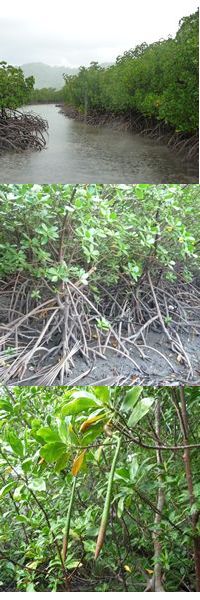
Mangroves act as stabilisers of the river banks against the huge volumes of seasonal water that comes pouring off the land after the rains, preventing all the soil from being washed away. The plant roots provide shelter for many creatures including file snakes, which are an important food source for the local people. The plants themselves also help with fishing. The seeds contain high quantities of chemicals called saponins, which are used to temporarily stun fish making them easier to catch! But one thing that we couldn’t do in the Northern Territory was get out and walk in the edges of the water around the mangroves – well we could but we would have been risking certain attack by crocodile! *
In Fiji, however, we were able to get up close and personal with a pristine area of mangroves on a small private island in the harbour of Savusavu on Vanua Levu. The island was completely surrounded by mangroves and we walked onto the island to see the plants up close. Three different types of mangrove were evident: a Rhizophora species that had very long mature seeds pods, a Barringtonia species which had a much chunkier fruit and a vine-like mangrove (our marine biologist tour guide did not have the name). The pneumatophores (knobbly knees) poked out of the mud and silt – these are the organs that help the plant's roots 'breathe' whilst growing in water. It was very obvious just how entangled the root systems were and why they are so effective at withstanding the battering from typhoons. Sadly large amounts of plastic rubbish had been washed up onto the sand that was locked in between the low lying mangrove areas. This rubbish is removed on a weekly basis. The mangrove habitat acts as a rubbish trap – the rubbish does not come from the nearby town but from all across the oceans. The currents push the rubbish towards the pacific islands and thankfully the mangroves extract it from the sea allowing it to be cleaned up.
The mangroves play many important roles – physical, nutritional, medicinal and ecological. Sadly many developers are trying to remove them from islands such as Fiji but at least in Savusavu the government recognise the importance of the habitat and are preventing damaging developments.
Alison Foster
Oxford Botanic Garden
* Editors note: Early Australian settlers confused these crocodiles with alligators hence the mis-named river. As the main differences lie in the shape, size and dentition of the jaws one can understand their reluctance to check!
Plants of the Month
Phacelia tanacetifolia Boraginaceae (Hydrophyllaceae)
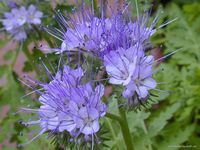
Phacelia makes an excellent addition to any garden – it will attract lots of beneficial insects to gobble up all the nasty aphids! It also makes an excellent cut-flower.
Alison Foster
Oxford Botanic Garden
Atropa Belladonna deadly nightshade, Solanaceae
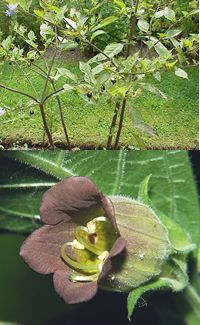
The tropane alkaloids include hyoscyamine. This is the name for the single optical isomer of this structure. This alkaloid occurs naturally in the plants named above. When attempts are made to isolate it, the single isomer is often partially converted to the other isomer thus giving a mixture of the two.
When the mixture of isomers (racemate) is isolated it is known as atropine. The natural isomer is roughly 20 to 30 times more active than the unnatural isomer. Another tropane alkaloid called hyoscine is found in these plants. The exact same molecule is also known as scopolamine.
Hyoscyamine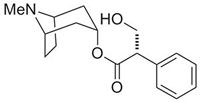 |
Hyoscine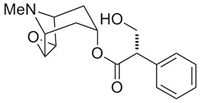 |
These chemicals have powerful biological activity at acetylcholine receptors. These receptors are part of the central and peripheral nervous system and can be subdivided into two groups – muscarinic and nicotinic. They are the natural receptors for the neurotransmitter acetylcholine. Muscarine, a molecule found in some mushrooms, mimics the action of acetylcholine at muscarinic acetylcholine receptors and nicotine, from tobacco plants, Nicotiana tabacum, mimics the action at nicotinic acetylcholine receptors. Responses caused by binding to these receptors include muscle contraction or relaxation, pupil dilation, decreased mucus production in the nose and throat and respiratory depression. Many organs of the body are affected and consequently a range of conditions and illnesses are treated by these alkaloids or analogues. Atropine is used as an eye drop to induce pupil dilation to allow examination of the retina. It is more rarely used as a pre-operative medication to dry bronchial and salivary excretions.
Atropine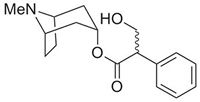 |
Hyoscine is prescribed for the treatment of motion sickness – either in the form of tablets or trans-dermal patches. Kwells and Joy-Rides both contain this compound. Like atropine, it is also useful to reduce salivary and bronchial excretions in different clinical situations.
A semi-synthetic derivative of hyoscine, hyoscine butyl bromide is the active ingredient in Buscopan, a treatment for the stomach cramps associated with Irritable Bowel Syndrome. The hyoscine used to make the drug is extracted from a special cultivar of Duboisia trees (Corkwood Tree), another member of the Solanaceae, grown especially in Australia and South America.
Deadly nightshade is a robust shrubby perennial with flowers of a murky purple colour (Picture above right by BerndH). In the autumn the shrubs will be covered with glossy black berries that look good enough to eat but be warned, hospitalization will soon follow!
Alison Foster
Oxford Botanic Garden
News from our Associates
Commercial Horticultural Association
The CHA is currently recruiting for two major overseas trade exhibitions where grant support from UK Trade and Investment will be available to eligible UK companies wishing to explore export markets.
International Hortifair : 1 Nov 2011 - 4 Nov 2011, Amsterdam, The Netherlands
Growtech Eurasia : 1 Dec 2011 - 4 Dec 2011, Antalya, Turkey
Grants will also be available for two exhibitions in 2012: IPM, Essen, Germany & Salon du Vegetal, Angers, France.
National Horticultural Forum
The Forum's latest report 'Research into use: The Strawberry and Brassica Crops' has been published. The report demonstrates the importance of support for transferring science into the technical innovation that the horticultural industry needs.
The forum has also launched its new website; http://www.hortforum.net
Horticulture Industry News
For the very latest horticultural news follow us on Facebook and or Twitter.
...and disease rained down upon the crops
In order for clouds to make ice, the usual precursor of snow, hail and rain, a particle must be present for the ice crystals to grow around, known as an ice nucleus. There is growing evidence that these nuclei can be bacteria or other biological particles. The plant pathogen Psuedomonas syringae, which attacks a wide range of crops, is commonly at the root of precipitation events. ‘Its outer surface is so efficient at collecting water molecules around it’, says Brent Christner of Louisiana State University. ‘Ice nucleating strains of P. syringae possess a gene that encodes a protein in their outer membrane that binds water molecules in an ordered arrangement,’ said Christner.
Virus makes thrips feed more
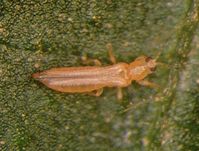
Strawberry boom threatens Spanish wildlife
Spain is the biggest exporter of strawberries worldwide, with an industry worth more than 400m euros (£345m) a year, which supports around 50,000 jobs. Intensive agricultural methods mean the fruit can be grown all year round. But this "red gold", as some Spaniards call it, has transformed not only European supermarket shelves, but also the landscapes of southern Spain. The fruit-farming area close to the town of Lucena del Puerto in Huelva, accounts for almost 90% of production in Spain but there is not enough water to supply this huge industry and according to the local water agency, as many as half of all strawberry farms in this region are taking water illegally. But that water is also what feeds one of Europe's most important wetlands, the Donana National Park. Its marshes are fed by underground aquifers but the water supplied by one of the main streams has fallen by half in the last 30 years. "This is a very important threat, because water is important for all in the park - for animals and even for vegetation," says Dr Carmen Diaz Paniagua, from Donana's research station. More
Storms hit Scottish soft fruit
Soft fruit producers in Scotland have said the storm on 23rd May was a "catastrophe" for the industry, causing millions of pounds of damage. The high winds have destroyed hundreds of acres of polytunnels in Tayside and Fife, leaving the fruit exposed. Replacing the tunnels alone costs about £12,000 per acre, farmers' co-operative Angus Growers said. William Houston, the general manager at Angus Growers, said the cost to farms could be as much as £30,000 per acre when the damage to tunnels, fruit and irrigation were taken into account. More
Seed germination triggered by ‘old’ genes.
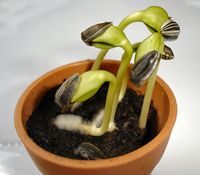
Self Healing Plants
Typically when a plant is injured, specialized cells at the wound site revert to a ‘pluripotent’ state, a process called dedifferentiation. The dedifferentiated cells rapidly divide to form a callus from which the damaged tissue or organ will regenerate. Now, a research team from the RIKEN Plant Science Center in Yokohama has identified a master regulator of the response of plants to injury. They had previously identified that the transcription factor WIND1 was expressed in cultured Arabidopsis cells but not in healthy seedlings. They have now demonstrated that WIND1 expression increases markedly at wound sites within hours of injury and continues throughout callus development.
Plant Clinics for Developing Countries
A "plant clinic" scheme to improve food security in developing nations has received a £6.8m boost from the UK and Swiss governments. The clinics, similar to human doctors' surgeries, offer local farmers advice on how to treat pests and diseases. The organisers also hope to collate data from front-line "plant doctors" to provide an early warning system. It is hoped that more than 400 clinics will be established in 40 countries over the next five years. Trevor Nicholls, CEO of Cabi (Centre for Agriculture Bioscience International) - a not-for-profit science body - said the investment of £1m from the UK government and £5.8m from Swiss ministers was a "significant endorsement for the initiative". More
Soil antibiotics
One of the most important new fields of biology is the study of microbiomes – communities of microorganisms that are closely associated with animals and plants. The trouble is, most of the bacteria and fungi that make up these microbiomes cannot be grown in a laboratory, as the conditions in which they are able to grow are unknown. With the rapid advancement of DNA and RNA sequencing technologies it is now possible to identify the microbes without ever having to grow them – a system known as metagenomics. Using these techniques a study has looked at the bacteria associated with the plant rhizosphere and compared two types of soil: one with disease-suppressive qualities, able to prevent the growth of fungal plant-pathogens, and another which was not able to impede fungal growth. By comparing the microbes present in each soil type the researchers identified an antibiotic-producing bacterium belonging to the Pseudomonadaceae that might protect plant roots from fungal infection. They went on to engineer a strain of this bacterium that could no longer make the antibiotic and found that although it could colonise the rhizosphere efficiently, it no longer offered protection to the plant against fungal infection. More
Scorpion Venom: Bad for Bugs, Good for Pesticides
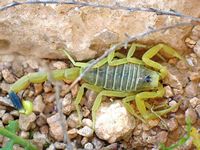
Quotes of the Month
Ignorance more frequently begets confidence than does knowledge.
Charles Darwin
Events Calendar
Greensys 2011
5 Jun 2011- 11 Jun 2011, International Society for Horticultural Science
Halkidiki, Greece
Sustainable Plant Protection Techniques in Fruit Growing
8 Jun 2011 - 10 Jun 2011, Centre Technique Interprofessionnel des Fruits et Légumes
Bergerac, France
Responsible Peatland Management and Growing Media Production
13 Jun 2011 - 17 Jun 2011, International Society for Horticultural Science
Quebec City, Canada
Future of Farming: What Needs to Change?
13 June 2011, Tropical Agriculture Association & University of Reading
Reading, UK
Agricultural Ecology Research: its role in delivering sustainable farm systems
15 Jun 2011 - 16 Jun, Association of Applied Biologists
Dundee, Scotland
Modelling in Fruit Research and Orchard Management
19 Jun 2011 - 23 Jun 2011, International Society for Horticultural Science
Saint-Jean-sur-Richelieu, Canada
Apricot Breeding and Culture
20 Jun 2011 - 24 Jun 2011, International Society for Horticultural Science
Yerevan, Armenia
The Landscaping Show
21 Jun 2011 - 22 Jun 2011, British Association of Landscape Indistries
Stoneleigh, UK
Augmenting production and utilisation of mango; Biotic and abiotic stresses
21 Jun 2011 - 23 Jun 2011, International Society for Horticultural Science
Lucknow, India
Rubus and Ribes Symposium
22 Jun 2011 - 26 Jun 2011, International Society for Horticultural Science
Zlatibor, Serbia
Underutilized Plants: Crops for the Future - Beyond Food Security
27 Jun 2011 - 1 Jul 2011, International Society for Horticultural Science
Kuala Lumpur, Malasia
GM Crops: From Basic Research to Application
28 Jun 2011 - 29 Jun 2011, Association of Applied Biologists
Harpenden, UK
Turf Show
28 Jun 2011 - 29 Jun 2011, Turfgrass, Growers Association
Richmond, UK
National Plant Show
28 Jun 2011 - 29 Jun 2011, Horticultural Trades Association
Stoneleigh, UK
Landscape and Urban Horticulture
29 Jun 2011 - 3 Jul 2011, International Society for Horticultural Science
Nanjing, China
Medicinal, Aromatic and Nutraceutical Plants from Mountainous Areas
6 July 2011 - 9 July 2011, International Society for Horticultural Science
Saas-Fee, Switzerland
Bee ecology and pollination in the agricultural landscape
7 July 2011, Society of Biology
Hatfield UK
Ohio Short Course
9 July 2011 - 12 July 2011, Ohio Florist Association
Columbus, USA
The co-evolution of bees and flowers
11 July 2011, Society of Biology
Farnborough, Kent, UK
The Woking Show
13 July 2011, The Woking Nurseries
Worplesdon, UK
Quality Management of Fresh Cut Produce: Convenience Food for a Tasteful Life
17 July 2011 - 21 July 2011, International Society for Horticultural Science
Turin, Italy
Fruit Focus
20 July 2011, Haymarket Media Group
East Malling, UK
Eastgro Horticultural Trade Show
3 Aug 2011
Diss, UK
Medicinal and Aromatic Plants
16 Aug 2011 - 19 Aug 2011, International Society for Horticultural Science
Petén, Guatemala
Keeping Pesticides out of Water Workshop
17 Aug 2011 - 18 Aug 2011, Association of Applied Biologists
Wageningen, The Netherlands
Plantarium
24 Aug 2011 - 27 Aug 2011,
Boskoop, The Netherlands
If you would like to advertise a forthcoming event please contact. zoe.daniel@soci.org
Horticulture Group Contact Details
For submitting ideas or to volunteer to be part of a committee or a group, please contact:
Acting Chairman - Peter Grimbly
Meetings Secretary - Marion Stainton
Minutes Secretary - Margaret Waddy
Newsletter co-ordinator - Sue Grimbly scihortigroup@btinternet.com
SCI contact - communications@soci.org T: +44(0)20 7598 1500
